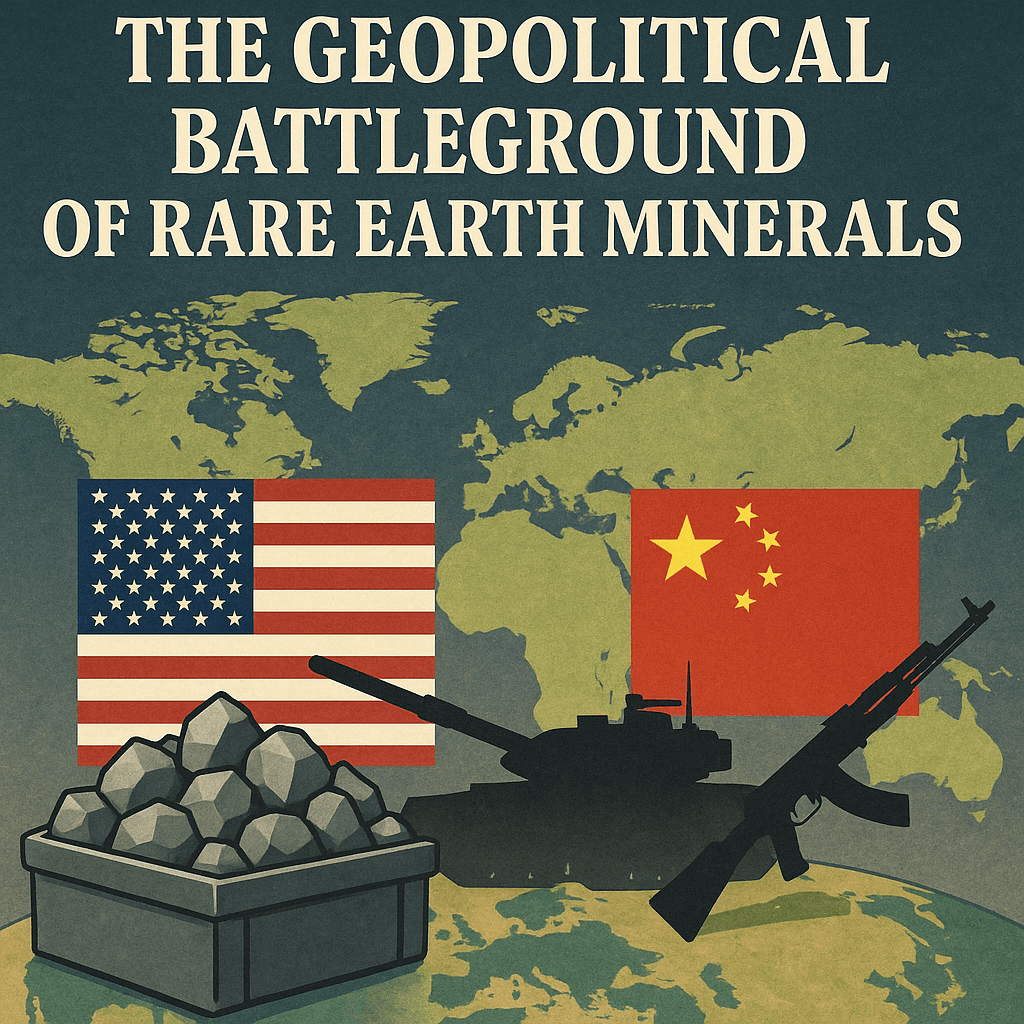
The Geopolitical Battleground of Rare Earth Minerals
Explore how rare earth minerals shape global politics as China dominates supply chains while the US seeks new partnerships with Ukraine, Greenland, and Canada to secure these vital resources.
8 Minute Read
Rare earth minerals have transformed from obscure elements to strategic resources that shape international relations. These resources now determine technological leadership, military capability, and energy transitions. As nations race to secure these critical materials, a complex geopolitical landscape emerges with China at its center and other powers scrambling to reduce their vulnerability.
In this article, you'll learn:
- What makes rare earth minerals strategically important.
- How China established and maintains its dominance.
- Why the US is pursuing partnerships with Ukraine, Greenland, and Canada.
- How rare earth minerals influence international alliances and conflicts.
- What the future holds for the global rare earth supply chain.
What Are Rare Earth Minerals?
While rare earth elements comprise 17 metallic elements on the periodic table, the name is misleading. These elements aren't actually rare in Earth's crust. They're quite abundant. The challenge is finding them in concentrated deposits that can be mined economically.
These minerals possess unique magnetic, luminescent, and catalytic properties. This makes them essential for modern technology. You'll find them in smartphones, electric vehicles, wind turbines, and military equipment. Without rare earths, the digital age as we know it wouldn't exist.
The green energy transition has dramatically increased demand. Electric vehicle motors require strong permanent magnets made with neodymium and dysprosium. Wind turbines use similar technology. As countries commit to reducing carbon emissions, the need for these minerals grows.
Defense applications further elevate their importance. Precision-guided weapons, radar systems, and electronic warfare equipment all depend on rare earths. This military dimension transforms these minerals from economic resources into national security assets.
China's Strategic Dominance
China controls the rare earth market through decades of deliberate policy. China holds about 34% of global reserves but accounts for 59% of production and 85% of refining capacity. This dominance didn't happen by accident.
As Deng Xiaoping famously remarked in 1992, "The Middle East has oil, but China has rare earths." This statement revealed China's strategic vision for these resources. The country invested heavily in mining and processing while other nations overlooked these minerals.
How did China achieve this position? Several factors contributed:
- Government subsidies for mining and processing
- Relaxed environmental regulations
- Strategic investments in technology
- Vertical integration of supply chains
China has leveraged this control for geopolitical gain. In 2010, during a maritime dispute with Japan, China restricted rare earth exports. This move sent shockwaves through global markets. It demonstrated how access to these minerals could be weaponized. Though the World Trade Organization later ruled these restrictions illegal, the message was clear.
Recent trends show China strengthening its position. Chinese companies have acquired lithium assets worldwide at twice the rate of Western companies. The growing relationship with Russia further enhances China's access to critical minerals. Russia now sells aluminum and nickel to China at below-market rates, strengthening their economic ties.
The Global Distribution Challenge
The uneven distribution of rare earth resources creates supply vulnerabilities for many countries. No single nation can achieve self-sufficiency. This reality drives the geopolitical competition we see today.
Global Rare Earth Minerals Distribution
| Country/Region | Reserves (Million Tonnes) | Resources (Million Tonnes) | Key Notes |
| China | 44 | 89 | Controls 85% of global refining capacity; produces 59% of global output. |
| United States | 1.8 | 3.6 | Mountain Pass mine accounts for most reserves; resources include untapped deposits. |
| Canada | - | 14 | Largest rare earth resources in North America; production scaling up. |
| Greenland | 1.5 | 5.8 | Untapped reserves include 18% of global neodymium and dysprosium. |
| Ukraine | 0.5* | 5.0* | *Soviet-era estimates, unverified; 50% of rare earths under Russian occupation. |
| Rest of World | 68.2 | 210 | Includes Brazil (18.3M reserves), Vietnam (3.5M), Russia (3.8M), India (5.8M), and others. |
In the rare earth minerals world, "reserves" and "resources" are not the same. Reserves represent mineral deposits that are economically viable to extract with current technology and market conditions. Resources, by contrast, include all known mineral deposits, even those not currently economically feasible to mine.
The distribution shown in the table explains why nations are racing to secure access through partnerships and investments. The stakes are simply too high to rely on a single supplier. Ukraine presents an interesting case with Soviet-era surveys suggesting 0.5 million tonnes of reserves and 5 million tonnes of resources. However, these estimates remain unverified by modern standards. Approximately 50% of Ukraine's rare earth deposits lie in Russian-occupied territories.
The US Response: Strategic Partnerships
Recognizing the vulnerability created by China's dominance, the United States has prioritized rare earth security. This strategy includes both domestic legislation and international partnerships. The Inflation Reduction Act and the CHIPS and Science Act contain provisions to strengthen critical mineral supply chains.
The US currently imports half of its critical mineral consumption. This dependency drives its pursuit of agreements with resource-rich allies and partners. Three regions have emerged as particular focuses: Ukraine, Greenland, and Canada.
The Ukraine Mineral Deal
The United States recently signed an agreement with Ukraine to develop its mineral resources. This deal represents a significant step in diversifying rare earth supplies. The partnership operates on a 50/50 basis with resources remaining Ukraine's property.
Key elements include:
- American assistance in attracting investment and technology
- No debt obligations for Ukraine
- Additional US assistance, potentially including defense systems
- Tax exemptions for the fund's income and contributions
Ukraine claims $15 trillion in total mineral wealth. This includes rare earths, lithium, and titanium. However, active conflict with Russia has stalled exploration. Approximately $350 billion worth of resources lie under Russian occupation as of May 2025.
Greenland's Untapped Potential
Greenland possesses the eighth-largest reserves of rare earth elements globally. A 2023 survey confirmed that 25 of 34 minerals deemed "critical raw materials" by the European Commission exist in Greenland. The island's resources include 18% of global neodymium and dysprosium reserves.
Despite this wealth, mining development remains limited. Only two operational mines currently exist. This underdevelopment stems from regulatory hurdles, environmental concerns, and indigenous opposition. The island has banned oil and gas drilling as well as deep-sea mining to protect its environment.
The US has actively countered Chinese interest in Greenland's resources. Reports indicate that the US urged an Australian mining company to avoid selling Greenland's largest rare earth project to Chinese buyers. This intervention shows the growing competition for these resources.
Canada's Growing Role in Rare Earth Minerals
Canada holds the largest rare earth resources in North America. The country is scaling up production, with projects like Nechalacho set to produce 5,000 tonnes annually by 2025. The US-Canada relationship builds on existing economic ties and shared security concerns.
The geographical proximity makes Canada an ideal partner. Supply chains between the two countries face fewer disruptions than those spanning oceans. This advantage becomes crucial during global crises like pandemics or regional conflicts.
Geopolitical Implications
The competition for rare earth minerals reshapes international relations in several ways. New alliances form around resource security. The minerals race drives new forms of international cooperation as countries recognize that no single nation can achieve self-sufficiency alone.
Western countries increasingly coordinate their approaches. This has led to initiatives like the Minerals Security Partnership. This partnership brings together like-minded countries to secure critical mineral supply chains against disruption.
For smaller resource-rich nations, this competition creates both opportunities and risks. Greenland's leaders view mining revenues as a potential path to reduce dependence on Danish subsidies. This could eventually help achieve independence. However, they must navigate competing interests from major powers while ensuring environmental protection.
The growing relationship between Russia and China has significant implications for mineral markets. In early 2023, bilateral trade between Moscow and Beijing reached $134 billion. This represented a 36% increase from the previous year. Their partnership allows both countries to mitigate Western pressure and creates a powerful bloc in the critical minerals space.
Future Trends and Solutions
Several trends will shape the future of rare earth geopolitics. Technological innovation may alter the landscape of dependency. Research into alternative materials, recycling methods, and more efficient use of existing supplies could reduce reliance on primary extraction.
Urban mining presents an interesting opportunity. This involves recovering rare earth elements from discarded electronics and other waste. The concentration of rare earths in electronic waste often exceeds that in natural ores. However, economic and technical challenges remain.
International governance frameworks may emerge to manage resource competition. The World Trade Organization ruling against China's export restrictions demonstrated how international institutions can address market distortions. More robust frameworks could help prevent future disruptions.
The environmental impact of rare earth mining will influence development. Traditional extraction methods generate significant pollution, including radioactive waste. More sustainable approaches could alter which deposits become economically viable. This could reshape the global supply map.
Climate change policies will drive demand growth. As countries pursue carbon neutrality, the need for rare earths in green technologies will increase. This growing demand will intensify competition for resources.
The Stakes for Global Security
The rare earth race has profound implications for international security. Military applications make these minerals essential for defense capabilities. Nations lacking secure access face strategic vulnerabilities.
The technological dimension extends beyond military applications. Leadership in emerging technologies like artificial intelligence, quantum computing, and biotechnology requires rare earth inputs. These technologies will define economic and military power in the coming decades.
Energy security increasingly depends on these resources. The transition from fossil fuels to renewable energy requires vast amounts of rare earths. Countries that control these supply chains gain influence over global energy transitions.
Economic coercion becomes possible through supply chain control. As China demonstrated in 2010, restricting access to rare earths can pressure other nations. This creates a new form of leverage in international disputes.
Summary: The New Great Game of Rare Earth Minerals
The race for rare earth minerals represents a new "Great Game" in international relations. These elements have become essential to technological leadership, military capability, and energy transitions. Their strategic importance will only grow as the world becomes more digital and less carbon-intensive.
Key takeaways:
- China's dominance in rare earth production and refining creates vulnerabilities for other nations.
- The US is pursuing partnerships with Ukraine, Greenland, and Canada to diversify supply chains.
- Environmental concerns, technological innovation, and international governance will shape future developments.
- Control of rare earth supplies translates directly into geopolitical influence.
- Nations must balance immediate access needs against long-term sustainability concerns.
As this competition intensifies, the winners will gain advantages across multiple domains - economic, technological, and military. The losers may find themselves dependent and vulnerable. In this context, rare earth minerals truly deserve their status as the strategic resources of the 21st century.
Related Articles
Latest Articles
800 Years of Mogok: A Celebration in Tenuous Times
What is the Average Gemstone Faceting Yield?
Pyroxmangite Value, Price, and Jewelry Information
How to Identify Emerald Simulants and Synthetics
Never Stop Learning
When you join the IGS community, you get trusted diamond & gemstone information when you need it.
